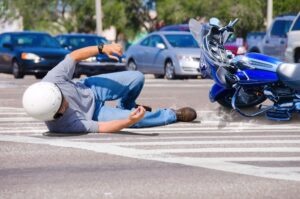Motorcycle accidents can result in devastating injuries and extensive damage. If a motorcycle accident hurt you, you may wonder if you need a lawyer to navigate the legal process and seek compensation for your injuries. In this article, we will explore why you need a motorcycle accident lawyer and how they can assist you in obtaining the compensation you deserve.
The Dangers of Motorcycle Accidents
 Motorcycle accidents pose unique risks due to the lack of protection that motorcycles offer compared to other vehicles. When involved in an accident, motorcyclists are more vulnerable to severe injuries or even death.
The absence of seat belts, airbags, and the inherent instability of motorcycles make riders particularly susceptible to the impact of a collision.
Additionally, motorcycles are often less visible to other drivers, increasing the likelihood of accidents caused by other motorists' negligence.
Motorcycle accidents pose unique risks due to the lack of protection that motorcycles offer compared to other vehicles. When involved in an accident, motorcyclists are more vulnerable to severe injuries or even death.
The absence of seat belts, airbags, and the inherent instability of motorcycles make riders particularly susceptible to the impact of a collision.
Additionally, motorcycles are often less visible to other drivers, increasing the likelihood of accidents caused by other motorists' negligence.
4 Common Motorcycle Accident Injuries
Motorcycle accidents can result in a wide range of injuries, varying in severity. Some of the most common injuries include:- Head injuries: Traumatic brain injuries (TBI) and concussions are prevalent in motorcycle accidents due to the lack of protection for the head. These injuries can have long-lasting effects on cognitive function and overall quality of life.
- Spinal cord injuries: Accidents involving motorcycles often lead to spinal cord injuries, which can cause paralysis or permanent disability. These injuries require extensive medical treatment and rehabilitation.
- Fractures and broken bones: The impact of a motorcycle accident can lead to fractures and broken bones throughout the body. These injuries may require surgical intervention and can result in long-term pain and limited mobility.
- Road rash: When a motorcyclist is thrown from their bike, they can suffer from road rash, which is caused by friction between the skin and the road surface. Road rash can range from mild abrasions to deep wounds requiring skin grafts.
What Are 4 Common Causes of Motorcycle Accidents?
Understanding the common causes of motorcycle accidents can help you identify who may be at fault and determine if legal action is necessary. Some common causes include:- Driver negligence: Many motorcycle accidents occur due to the negligence of other drivers on the road. This can include distracted driving, speeding, failure to yield, or driving under the influence of alcohol or drugs.
- Poor road conditions: Hazardous road conditions, such as potholes, uneven surfaces, or debris, can cause motorcyclists to lose control and crash. In these cases, the responsible party may be the government entity responsible for maintaining the roadways.
- Defective motorcycle parts: If a motorcycle accident is caused by a defect in the bike or its parts, the manufacturer or distributor may be held liable for the resulting injuries.
- Unsafe lane changes: Motorcycles are often overlooked by other drivers when changing lanes, leading to collisions. Failure to check blind spots or properly signal can result in devastating accidents.
When to Hire a Motorcycle Accident Lawyer
If you have been injured in a motorcycle accident, it is advisable to consult with a motorcycle accident lawyer as soon as possible. They can help you navigate the complex legal process and protect your rights. Here are some situations where hiring a lawyer is particularly important:- Severe injuries: If your injuries are severe and require extensive medical treatment, rehabilitation, or long-term care, a lawyer can help you seek the compensation necessary to cover these expenses.
- Disputed liability: If there is a dispute over who is at fault for the accident, a lawyer can gather evidence and build a strong case to establish liability and hold the responsible party accountable.
- Insurance company resistance: Insurance companies often try to minimize payouts or deny claims altogether. A motorcycle accident lawyer will negotiate with the insurance company on your behalf to ensure you receive a fair settlement.
- Emotional distress: Motorcycle accidents can cause emotional distress and trauma. A lawyer can help you seek compensation for pain and suffering resulting from the accident.
What Are 4 Ways a Motorcycle Accident Lawyer Can Help with Insurance Claims?
Navigating the insurance claims process after a motorcycle accident can be overwhelming, especially while dealing with injuries and recovery. A motorcycle accident lawyer can assist you in several ways:- Gathering evidence: A lawyer will gather all necessary evidence to support your claim, including police reports, witness statements, medical records, and any other relevant documentation.
- Communicating with insurance companies: Your lawyer will handle all communication with the insurance company, ensuring that your rights are protected and that you do not inadvertently say something that could harm your case.
- Negotiating a fair settlement: Insurance companies often offer initial settlements that are far below what you are entitled to. A motorcycle accident lawyer will negotiate on your behalf to secure a fair settlement that covers your medical expenses, lost wages, and other damages.
- Litigation representation: If a fair settlement cannot be reached through negotiation, your lawyer will be prepared to take your case to court and advocate for your rights before a judge and jury.
The Importance of Gathering Evidence After a Motorcycle Accident
Gathering evidence after a motorcycle accident is crucial for building a strong case and proving liability. Here are some essential steps to take:- Contact the authorities: Immediately after the accident, call the police to report the incident. They will create an official accident report, which can serve as valuable evidence.
- Seek medical attention: Even if you do not believe you are seriously injured, it is essential to seek medical attention as soon as possible. Some injuries may not be immediately apparent, and a medical evaluation will document any injuries sustained in the accident.
- Document the scene: If you are physically able, take photographs and videos of the accident scene, including any damage to your motorcycle and other vehicles involved. These visual records can provide valuable evidence.
- Collect witness statements: Obtain contact information from any witnesses to the accident. Their statements can help corroborate your version of events.
What Are 4 Roles a Motorcycle Accident Lawyer Plays in Negotiating Settlements?
One of the primary roles of a motorcycle accident lawyer is to negotiate settlements with insurance companies on behalf of their clients. Insurance companies often employ tactics to minimize payouts, but a lawyer will fight for your rights and seek fair compensation. Here's how a lawyer can help with settlement negotiations:- Determining the value of your claim: Your lawyer will assess the full extent of your damages, including medical expenses, lost wages, property damage, pain and suffering, and any other relevant factors. This evaluation ensures that you pursue a fair settlement that adequately compensates you for your losses.
- Presenting a strong case: Your lawyer will gather all necessary evidence, including medical records, accident reports, expert opinions, and witness statements, to present a compelling case to the insurance company. This evidence establishes liability and demonstrates the extent of your injuries and damages.
- Negotiating with insurance adjusters: Insurance adjusters are adept at minimizing payouts and may try to pressure you into accepting a low settlement. Your lawyer will negotiate with the insurance company on your behalf, using their knowledge of personal injury law and experience in settlement negotiations to secure the best possible outcome.
- Preparing for litigation if necessary: If a fair settlement cannot be reached through negotiation, your lawyer will be prepared to take your case to court. They will strategically build your case, gather additional evidence, and represent you in litigation to pursue the compensation you deserve.
4 Roles Insurance Companies Play During the Claims Process
Insurance companies play a significant role in the claims process following a motorcycle accident. However, it is important to remember that their primary goal is to protect their own interests and minimize payouts. Here are a few things to keep in mind when dealing with insurance companies:- Promptly reporting the accident: Notify your insurance company promptly after the accident, even if you believe the other party is at fault. Failure to report the accident promptly may result in denial of your claim.
- Providing accurate information: When communicating with the insurance company, provide accurate and truthful information. Any inconsistencies or misrepresentations may be used against you and could harm your claim.
- Avoiding recorded statements: Be cautious when providing recorded statements to the insurance company. It is best to consult with a motorcycle accident lawyer before making any statements to ensure that your rights are protected.
- Reviewing settlement offers carefully: Do not accept a settlement offer without consulting with a lawyer. Insurance companies often offer low initial settlements, hoping that you will accept less than you deserve. A lawyer can help you evaluate the offer and negotiate for a fair settlement.
What Are 4 Factors to Consider When Choosing a Motorcycle Accident Lawyer?
Selecting the right motorcycle accident lawyer is crucial to the success of your case. Here are some factors to consider when making your decision:- Experience: Look for a lawyer with extensive experience in personal injury law, particularly in handling motorcycle accident cases. An experienced lawyer will have the knowledge and skills necessary to navigate the complexities of your case.
- Track record of success: Research the lawyer's track record and determine their success rate in securing favorable settlements or verdicts for their clients. Client testimonials and online reviews can provide valuable insights into their reputation.
- Resources and network: A reputable motorcycle accident lawyer will have access to a network of professionals, including accident reconstruction experts, medical experts, and investigators. These resources can strengthen your case and increase your chances of success.
- Communication and availability: Choose a lawyer who is accessible and responsive to your needs. Effective communication is essential throughout the legal process, and you want to ensure that your lawyer is readily available to address your concerns.
What Are 4 Common Misconceptions About Motorcycle Accident Lawsuits?
There are several misconceptions surrounding motorcycle accident lawsuits that can hinder individuals from seeking legal representation. Here are a few common misconceptions debunked:- Motorcyclists are always at fault: While there is a stereotype that motorcyclists are reckless and often cause accidents, this is not true. Motorcycle accidents can be caused by a variety of factors, including the negligence of other drivers or hazardous road conditions.
- I can handle the claim on my own: It is possible to handle a motorcycle accident claim independently, but it is not advisable. The legal process can be complex and overwhelming, especially when dealing with injuries and recovery. Hiring a motorcycle accident lawyer will ensure that your rights are protected, and you receive the compensation you deserve.
- Legal representation is too expensive: Many motorcycle accident lawyers work on a contingency fee basis, meaning they only get paid if they successfully recover compensation for you. This arrangement allows individuals with limited financial resources to access quality legal representation without upfront costs.
- The legal process takes too long: While the legal process can be time-consuming, having a motorcycle accident lawyer by your side can help streamline the process. They will handle all the necessary paperwork, negotiations, and court proceedings, allowing you to focus on your recovery.
The Benefits of Hiring a Motorcycle Accident Lawyer
 Hiring a motorcycle accident lawyer offers numerous benefits and can significantly improve the outcome of your case.
Here are some advantages of seeking legal representation:
Hiring a motorcycle accident lawyer offers numerous benefits and can significantly improve the outcome of your case.
Here are some advantages of seeking legal representation:
- Legal experience: Motorcycle accident lawyers are well-versed in personal injury law and have in-depth knowledge of the legal process. They understand the complexities of motorcycle accident cases and can navigate the system effectively on your behalf.
- Fighting for your rights: A lawyer will tirelessly advocate for your rights and ensure that you are treated fairly throughout the legal process. They will fight to maximize your compensation and hold the responsible party accountable for their negligence.
- Access to resources: Motorcycle accident lawyers have access to a network of professionals, including accident reconstruction experts, medical experts, and investigators. These resources can strengthen your case and increase your chances of success.
- Peace of mind: Dealing with the aftermath of a motorcycle accident can be overwhelming and stressful. Hiring a motorcycle accident lawyer allows you to focus on your recovery while they handle the legal aspects of your case.
Motorcycle Accident Lawsuits: 5 Steps to Expect During the Legal Process
Understanding what to expect during the legal process can help alleviate some of the stress and uncertainty following a motorcycle accident. While every case is unique, here is a general overview of the legal process:- Initial consultation: You will meet with a motorcycle accident lawyer for an initial consultation. They will evaluate the merits of your case, explain the legal process, and answer any questions you may have.
- Investigation and gathering evidence: Your lawyer will conduct a thorough investigation, gathering evidence to support your claim. This may include reviewing accident reports, interviewing witnesses, collecting medical records, and consulting with experts.
- Demand letter and settlement negotiations: Your lawyer will prepare a demand letter, outlining the extent of your damages and presenting a settlement amount to the insurance company. Negotiations will commence, and your lawyer will work to secure a fair settlement on your behalf.
- Litigation and trial: If a fair settlement cannot be reached, your lawyer will prepare your case for litigation. This may involve filing a lawsuit, attending hearings, and presenting your case before a judge and jury.
- Resolution and compensation: If your case goes to trial, a verdict will be reached. If successful, you will recover compensation for your injuries and damages. If a settlement is reached, you will receive the agreed-upon amount.
Get Your Free Consultation with Lorenz & Lorenz Accident & Injury Lawyers PLLC

